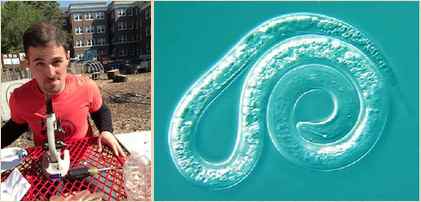
(left) Darym Alden, Earth Matter Apprentice (right) Nematode, a microscopic organism or “microbe”
by Darym Alden, Earth Matter Apprentice
As much as we all love Charlie and Marisa, they are not my favorite coworkers. Nor is it, our coordinator, Susan, my fellow apprentices, Clay, Angela, and Andrea, nor any of the many other passionate Earth Matter Volunteers; not even Walter, our dedicated “Rot Star” of the Month.
No. Since starting as an Apprentice Composter at Earth Matter, I have discovered that my favorite coworkers aren’t people at all, but there are still quite a few of them. In fact, although I can’t see them with my own eyes, I live with and encounter trillions of them every day.
Yes, that’s right. My favorite coworkers are microbes. Without microbes a composter’s job would not exist, and our entire planet would be covered in waste. “Microbes” is a blanket term for all the microscopic organisms that we cannot see with the naked eye; and a subset of them, called decomposers, are responsible for the process of decomposition, the breakdown of biological materials like tree twigs and food scraps into simple nutrients that can once again be ingested by new life. A large part of composting consists of making these microbial decomposers as happy as possible so that they can grow and continue recycling the biological materials we feed them. We water and mix our compost piles to create the optimal environment for their growth. This is one group of coworkers that we are always eager to please.
Keeping these microbes productive also requires tracking of their growth and activity. If you compost at home, the easiest way to make sure your microbes are at work is to monitor the temperature of your compost. Active microbes produce heat as a byproduct and will cause the temperatures of compost to rise. In fact, even in the winter an active at-home compost bin can reach temperatures up to 80 degrees Fahrenheit while mid to large-scale compost piles like ours can reach temperatures as high as 160°F. How’s that for an outdoor heater?
At the end of the day, tracking heat can only provide a general sense of the microbes in a compost pile. In order to gain an in depth look at our microbes, we also recently sent our finished compost to Earthfort for laboratory analysis. But why look at microbes in finished compost? Aren’t the microbes already finished doing their job? The short answer is no, not even close.
Soil microbes not only recycle biological material but also provide plants with greater access to nutrients and protection from pests. However, nutrient imbalances due to excessive use of chemical fertilizer and compacted soil due to foot traffic or intensive farming can heavily damage or imbalance a soil’s microbial ecosystem. In addition to providing nutrients and helping rebuild soil structure,high quality compost can also serve as a rich microbial inoculant, bringing dead soil back to life.
With the help of Earthfort, we discovered that our compost is full of life, holding over ten billion bacteria and microbial fungi in just one gram. That’s over one hundred billion bacteria and fungi in less than a tablespoon of compost! We also learned that our compost contains about ten thousand protozoa and twenty nematodes per gram. Protozoa are single-celled organisms that are usually much larger than bacteria; while nematodes are microscopic worms that, depending on the species, can eat bacteria, fungi, plants, or even other nematodes. Together with bacteria and fungi, protozoa and nematodes complete the four major groups of microbes that constitute the micro-verse of the soil.
Without all the life behind it, the transformation of a pile of food leftovers, leaf litter, and wood chips weighing several tons into a final product that looks and smells like soil would be impossible; but thanks to the Earth Matter team, our compost is thriving with life. What I once considered food waste is instead being turned into valuable fertilizer for parks, gardens and farms all over New York City.
